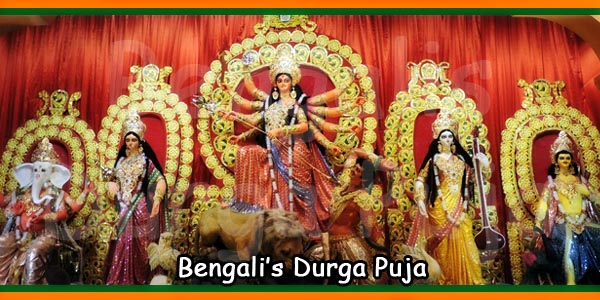Durga Puja festival begins with Mahalaya, the first phase of waxing moon in the month of Aswin. On this auspicious day, people perform a ritual called Tarpan at the river banks by offering prayers to their ancestors. Unveiling of the idol of Goddess Durga begins on Mahashasthi. The main puja continues on Mahasaptami, Mahaastami and Mahanavami. The rituals of Durga Puja, which involve mantras, Arati and offerings are of very complicated in nature and hence need to be performed by an expert priest. Because of this complexity, Pujas performed in the families are found to be declining and as such Durga Puja has mostly become a community festival.
Mahashashthi:
It is believed that on the Mahashashthi day Goddess Durga, together with her children, arrives to this earthly world from her heavenly abode. She is given a warm welcome amidst the festive atmosphere filled with beats of dhak. The main ritual on this day is the unveiling of the face of the Goddess idol. Kalaparambho is the ritual that is performed before the beginning of the puja, which is then followed by Bodhon, Amontron and Adibas.
Significance of Durga Puja:
Durga Puja is the day in which the Divine Mother is worshipped in different forms like Durga, Lakshmi and Saraswati. These three forms represent the three different aspects of the Goddess. During the nine-day-long festival, Durga is worshipped on the first three nights, Lakshmi on the next three nights, and Saraswati on the last three nights. The tenth day is Vijayadasami, which represents one’s victory over one’s own mind, which can be achieved only when Durga, Lakshmi, and Saraswati are worshipped.
Meaning of Durga:
Durga, meaning “one who is difficult to approach”, is the most popularly worshipped deity of Shakti. Devibhagavatham is completely dedicated to the divine depiction of Maa Durga. Goddess Durga is worshipped as the Mother of Universe and she is regarded the manifestation of all good qualities including love, beauty, wealth and power.
Implications of the Idol:
The image of Goddess Durga symbolically represents protection of good and destruction of evil. It reveals the message that those who seek divinity should control their animal instincts. Hence Durga worship refers to merciless demolition of all desires and evil qualities to unfold divinity within.

Implication of Durga Puja:
ln Bengal, there is a nine-day worship of Goddess Durga. As per South Indian custom, small images of gods, birds, animals, and other animate and inanimate beings are placed on a decorated altar, known as ‘Kolu’ and worshipped during the nine-day festival. It is the day that initiates the beginning of learning and on this day a child begins to learn alphabet and the ceremony is known as ‘aksharabhyasa’. Usually students offer gifts to their teachers and pursue their blessings. People pray for success in their new activities.
Saptami:
Saptami marks the first day of Durga puja. On this day, Kola Bow, also called Nabapatrika, is given a pre-dawn bath. This is an ancient tradition by which nine types of plants are worshipped together, symbolically representing the goddesses. The main Puja is followed by Kalparambho and Mahasnan.
Mahaashtami:
In the beginning of the day, thousands of devotees offer anjali to the goddess by reciting Sanskrit shlokas in the community puja venue. Many traditional and household pujas involve a special part known as ‘Kumari Puja’ or the worship of little girls as mother goddess. Finally there is an important puja known as Sandhi Puja, which marks the interconnection of Maha Ashtami and Maha Navami.
Mahanavami:
Durga Puja concludes on Mahanavami. The main puja of Mahanavami begins after the finishing of Sandhi Puja. The Navami Bhog, offered to goddess Durga, is later consumed by devotees as Prasad.
Vijaya Dashami:
Vijaya Dashami, celebrated all over the country, is the last day of the festival, when the goddess is offered a farewell. After carrying in processions, the images are finally immersed in a river or lake.
